

Merced County


-Advocating for agriculture since 191712th Annual FARM2U Day
By: Denelle Garcia, Farm News Editor
On October 3rd, Merced County Farm Bureau (MCFB) hosted our 12th Annual FARM2U Day at the Merced County Fair. FARM2U Day is an agriculture and nutrition education field trip open to all third-grade classes in Merced County. We were happy with this year’s attendance as we had 76 classes participate, reaching about 2,000 students. As our largest educational event of the year, we hope students leave knowing more about where their food comes from and healthy eating habits they can implement at home. Each class was able to see six different presentations from individuals of our local ag community, therefore learning the diversity of Merced County agriculture. Our goal of this event is to leave a lasting impression of the importance agriculture plays in our daily lives for not only the students, but the parents
and teachers that also attend.
We want to extend a huge thanks to all of our event sponsors, presenters, volunteers and local FFA chapters that played a vital role in making this event a success. Merced County Farm Bureau is proud to offer a variety of educational opportunities for youth through our programs like Rooted in Ag & Agribee. The success and continuation of our educational efforts is highly dependent on sponsorships & involvement from our members. We hope our membership continues to support these efforts, as they are highly impactful and valuable. If you are interested in getting more involved with your county farm bureau, we are always looking for volunteers to help at our various events throughout the year. Feel free to contact the office via phone (209) 723-3001 or email info@ mercedfarmbureau.org for volunteer opportunities.
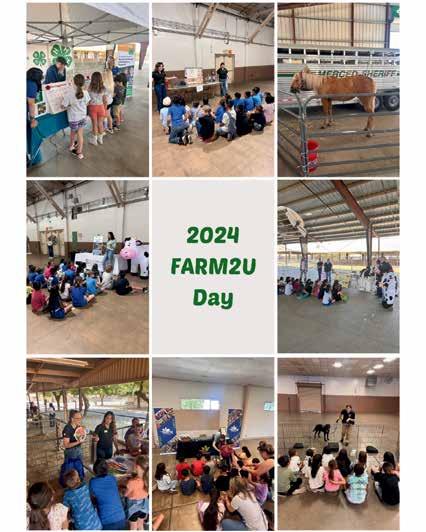



Here to tackle the unfun assignment this week is my article on membership dues. Previous articles by Dave provided information on a mid-year meeting held by California Farm Bureau in early August. Representing MCFB were Dave Barroso, Tim Lohman, Dante Migliazzo and Joe Sansoni. Months of preparation went into this for our directors and staff which also involved MCFB presenting an amendment heard before the voting delegation. The discussion for this meeting rested on the proposed action by California Farm Bureau Board of Directors to raise dues for membership.
To better understand this, you should know that at the grassroots level you are considered a member of Merced County Farm Bureau. Our organization, MCFB, is a member of California Farm Bureau. After much debate, the House of Delegates elected to raise the dues paid to California Farm Bureau. This does have a trickle-down effect on your membership at the local level and you will notice that adjustment when you receive your membership renewal.
There are a few things to keep in mind. First, a portion of every membership dues paid to a county farm bureau are paid to CAFB. Second, none of the membership dues sent to California Farm Bureau are used within FARM PAC as this is a separate entity. MCFB is then left with the remainder amount and couples this with donations, grants and investment funds to ensure we can keep our organization operational. We have experienced the same financial times that you have and our team has made various budget cuts, and continue to look to where we can find more, just as you have on your operations.
The conversation on if a person should be a farm bureau member can settle to a few reasons. The most common can be, “Why should I be a member when I continue to have to incur greater regulation and costs day in and day out?” I know
I carry a biased opinion when it comes to this, but I’ve sat through several meetings over the course of ten years that have led me to believe that we have been able to change policy, opinions and outcomes for the better because of your membership to MCFB. This has occurred at all levels of government. I encourage you to speak with any board member and especially any that have sat as an executive team member or officer of our organization. Currently, our staff wrapped FARM2U Day,
jumped right into our CE Courses and has been highly monitoring our local conditions of Avian Flu (H5N1). This doesn’t stop throughout the year as we continue to work to bring you new programs and events that are helpful to your organization while advocating for you while you’re busy on the ranch. As you receive your renewal notice, we hope you continue to find it an easy decision to sign the check. We’re always here to answer any question or concern you have.
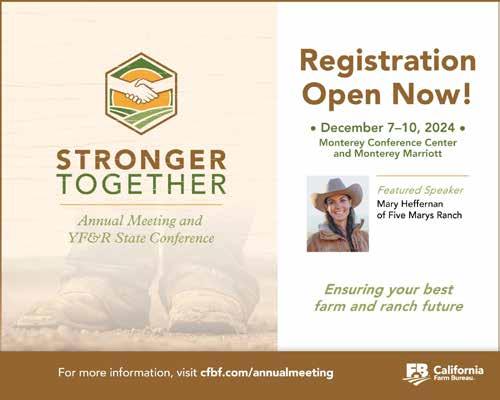


Well, another month has quickly passed. Hard to believe that it is already October and fall is supposedly here, although it maybe hard to tell with the recent 100 plus degree days. Just as the weather is hot so is this crazy, sometimes annoying, election season. As we discuss our weather concerns let’s keep those on the East Coast in our thoughts and prayers as they deal with back-to-back massive hurricanes, and widespread devastation.
Your Merced County Farm Bureau has been busy. On the 3rd of October Merced County Farm Bureau held their annual FARM2U Day. We also held a candidate forum during our last board meeting.
By this time, we should all be receiving our ballots for the upcoming November general election. The ballot is filled with 10 propositions, numerous national, state and local elections and depending on your location numerous other bonds and measures. Everyone in Merced County will get the chance to vote on Measure R. Measure R is a countywide ½% sales tax increase that will go to public safety. It is supported by Merced County Sheriff Vern Warnke and District Attorney Nicole Silviera, amongst others. It is also worth noting what our friends in Sonoma County are having to deal with in terms of their local measure, Measure J. A group of
animal rights extremist were able to a measure impacting local agriculture for their county. This is ground zero for this ridiculousness and hopefully our friends in Sonoma County can strongly defeat this measure and stop this ignorance from spreading. Since our last Farm News there has been a vice-presidential debate, and the contrast between the two leading political parties’ candidates were again put on display for the final debate in this cycle. There was also the final debate between Senatorial Candidates, Steve Garvey and Adam Schiff. If you are undecided on this crucial race, please watch at least parts of it and the contrast could not be clearer. Whatever you do, take time to educate yourself and help those around you vote for a prosperous, safe and healthy future.
On October 3rd, Merced County Farm Bureau hosted its annual FARM2U day at the Merced County Fairgrounds. FARM2U is an event for all Merced County 3rd grade students to hear presentations from different members of the agriculture community. This is a great event that gives over 2,000 3rd graders exposure to agriculture. Many of these students come from urban schools and this might be the only agriculture exposure and education that
they receive. Even with the agriculturally rich area we live in, there are far too many kids that are not exposed to agriculture. This event is a lot of work to put on and a big thank you to Merced County Farm Bureau staff, presenters, local FFA chapters, volunteers, those who graciously donated and teachers and schools that participated. Without all of them this event would not be possible.
At our September Board of Directors Meeting we hosted a candidate debate night. Assembly candidates for Districts 22 and 27 were invited. District 22 was represented by Assemblyman Juan Alanis while his Democrat challenger Jessica Self decided to not participate. The board had the opportunity to interview Assemblyman Alanis and elected to endorse his campaign which would represent most of Stanislaus County and a portion of Merced County. Assembly District 27 was a debate between incumbent Esmarelda Soria

and Republican challenger Joanna Garcia-Rose. We want to thank both of them for attending and participating in a spirited, yet respectful debate that included questions from board members in attendance. Your board decided to not endorse either candidate in this race. We would like to thank all the candidates and their staff that took time to attend and participate.
Hopefully everyone is winding up a successful, safe harvest season. By the time you receive your next Farm News hopefully we will have the election results, and we will be dealing with the aftermath. If you are not registered you have until October 21st to do so. Please take the time to let your voice be known and take the time to make sure family and friends do as well. Find out if friends and family need help filling out their ballots or getting them turned in on time. Also take time to educate yourself and be active. As always reach out to any board member or the office with any concerns.





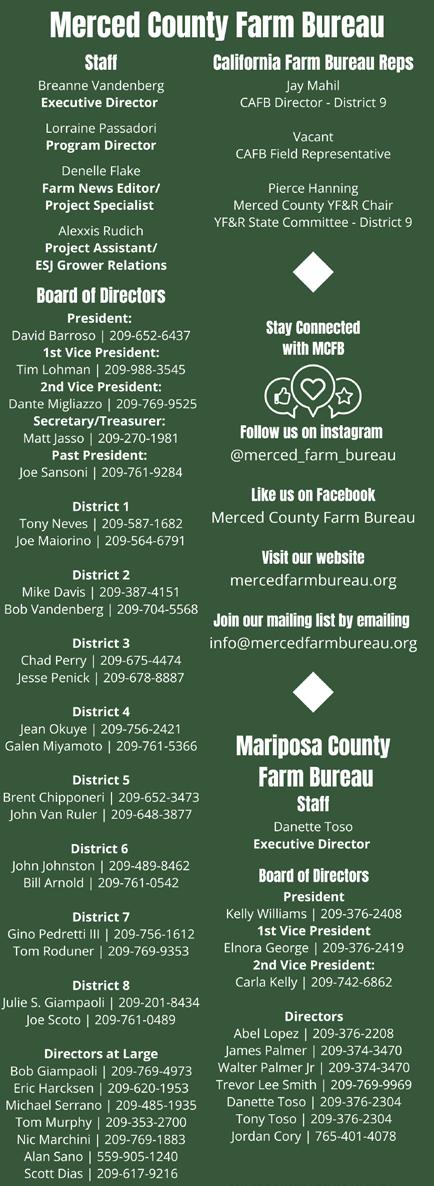
Atwater High School FFA Students Promote “FARM2U”
By: Marissa Vargas, Atwater FFA
The Atwater High School FFA officers joined nearly one hundred presenters and around 2500 third grade students from local schools throughout Merced County and participated in Merced County Farm Bureau’s annual “Farm2U” event on October 3rd at the Merced County Fairgrounds. The purpose of the event was to build a connection between our future generations and the importance of agriculture. “There are common misconceptions relating to agriculture and the agricultural industry, and we wanted to showcase with the younger generation the positive aspects and importance of agriculture,” said Atwater FFA Advisor Madison Zittel.
The 2500 third-grade students visited Merced County Fairgrounds received “handson” experiences of various agricultural industry sectors.
“This is an amazing event and activity for young kids to be exposed to one of our community's largest industries,” said Atwater High School agriculture instructor Taylor Helton.
“The opportunity to get kids excited to learn about agriculture and its importance to us all is very rewarding.”
Various agriculture industry representatives from the county also participated in the event, along with other local FFA chapter members.
“Many kids don’t have the opportunity to see and be around anything agricultural related and the goal is that this experience will result in a greater appreciation for agriculture,” said Atwater FFA member Callie Sanders.
“Our chapter is focusing on “community” and this event provided us the opportunity to interact with a future generation of students and teach them the value and importance of agriculture.”
Atwater High School FFA continues to get members involved in making a
positive difference within the community through opportunities
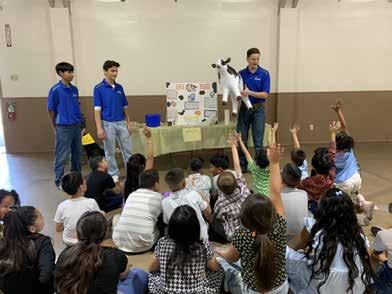
Atwater FFA, you can log onto AtwaterFFA.org website or follow them on Facebook, Instagram, and/or Twitter. Atwater High School FFA chapter officers Eric Villalobos, Iker Chargoy, and Gannon Gossman share

VOTER GUIDE 2024
2024 General Election • Tuesday, November 5
The California Farm Bureau Federation Board of Directors adopted the following recommendations on statewide ballot measures that will be before California voters in the Nov. 5 general election.
PROPOSITION
PROPOSITION 2: Issue $10 Billion in Bonds to Fund Construction and Modernization of Public Education Facilities
New construction and modernization of education institutions will cost $8.5 billion for K-12 and $1.5 billion for community colleges.
PROPOSITION 3: Removes Outdated Language Regarding Marriage from State Constitution
Repeals the unenforceable constitutional provision that marriage only between a man and woman is valid or recognized in California.
PROPOSITION 4: The Safe Drinking Water, Wildfire Prevention, Drought Preparedness, and Clean Air Bond Act
Allows for the issuance of $10 billion in bonds to fund safe drinking water; drought, flood, water resilience; wildfire and forest resilience; nature-based climate solutions; climate-smart, park creation and outdoor access; and clean air programs among other programs. Allows for funding to be shifted from the state budget to bonds for ongoing programs.
PROPOSITION 5: Lower Supermajority Requirement to 55% for Local Bond Measures to Fund Housing and Public Infrastructure
Amends the constitution to lower the threshold from 2/3 vote to 55% to allow a local government to impose a parcel tax for the purpose of issuing bonds to build or rehabilitate public infrastructure and affordable housing, including downpayment assistance, or permanent supportive housing.
PROPOSITION 6: Amend the California Constitution to Bar Involuntary Servitude in Correctional Facilities
Removes a constitutional provision allowing jails and prisons to impose involuntary servitude as criminal punishment. It prohibits the Department of Corrections and Rehabilitation from disciplining inmates for refusing work assignments while allowing inmates to voluntarily accept work assignments for credits to reduce their sentences.
PROPOSITION 32: $18 Minimum Wage Increase
Increases the minimum wage from $16 per hour to $18 per hour by January 1, 2025.
PROPOSITION 33: State Limitations on Local Rent Control
Allows a city or county to enact rent control by repealing the Costa-Hawkins Rental Housing Act of 1995.
PROPOSITION 34: Restrictions on AIDS Healthcare Foundation Support
Ensures that health care providers spend 98% of revenues on direct patient care if their spending on items other than patient care exceeds $100 million over 10 years.
PROPOSITION 35: Permanent Managed Care Organization (MCO) Tax
Makes permanent the existing tax on managed health care insurance plans, currently set to expire in 2026. The revenue generated pays for health care services for low-income families with children, seniors, disabled persons and other Medi-Cal recipients.
PROPOSITION 36: Drug and Theft Crime Penalties and Treatment-Mandated Felonies
Allows for felony charges and increases sentences for certain drug and theft crimes, including organized theft.
POSITION
OPPOSE
REASONING: California is already paying off billions in bond debt, all at a cost to the general fund to service the debt payments.
NO POSITION
REASONING: CAFB does not have policy on this topic.
OPPOSE
REASONING: Shifting government program costs from general tax revenues to additional public indebtedness through bond issuance to mitigate budget shortfalls is bad fiscal policy.
OPPOSE
REASONING: The 2/3 vote for taxes and fees is paramount and should not be weakened.
NO POSITION
REASONING: CAFB does not have policy on this topic.
OPPOSE
REASONING: California is already a difficult and costly state to do business in without an increasing minimum wage.
OPPOSE
REASONING: Private property rights are paramount.
NO POSITION
REASONING: CAFB does not have policy on this topic.
NO POSITION
REASONING: CAFB does not have policy on this topic.
SUPPORT
REASONING: Law enforcement should have all the tools necessary to prevent crime from occurring.





ATTENTION
Farmers and Farm Employees who need to renew their DL-267 Endorsement or acquire their initial endorsement.

The Agricultural Hazardous Materials Transportation Program is being offered by the Farm Bureau and Nationwide Insurance. This class is for persons 21 years or older and have a current California Class C drivers license.
Due to new requirements, once a person completes the course, they must:
• Submit completed training record along with a completed CHP application
• Await paperwork return from CHP
• Pay any applicable DMV fees
• With returned CHP paperwork apply for DL-267 certificate from the DMV
YOUR VOTER GUIDE: Here’s who, what’s on the Nov. 5 ballot in Merced and the San Joaquin Valley
By: Tim Sheehan, Fresno Bee
Welcome to The Merced Sun-Star’s Voter Guide to California’s Nov. 5 general election. Early mail-in voting for the election opens this week, and voters in various parts of Merced and the central San Joaquin Valley have much more to choose than simply who will occupy the White House for the next four years.
In Merced County and across the Valley, there are races for seats on city councils, county boards of supervisors, school boards and others. There are also eight local ballot measures, including school bonds and others, for voters to decide.
That’s on top of state legislative and Congressional contests. Taken in total, it makes for a full ballot to navigate.
We’ve compiled everything you need here to help you make informed decisions, including links to election stories and profiles of candidates and measures up for consideration. Select election stories include answers from candidates to questions submitted by The Sun-Star for this guide. You’ll also find links to editorial staff endorsements for various races and measures.
WHAT’S ON THE BALLOT?
U.S. President: The top of the ballot is the race for President and Vice President of the United States, which
pits Vice President Kamala Harris, the Democratic nominee, and her running mate, Minnesota Gov. Tim Walz, against the Republican ticket, former President Donald Trump and his running mate, Ohio Sen. J.D. Vance.
U.S. Senate: Candidates seeking a six-year term are Democrat Adam Schiff and Republican Steve Garvey. Incumbent U.S. Sen. Laphonza Butler, appointed following the death of longtime Sen. Dianne Feinstein, is not seeking reelection.
U.S. House of Representatives: Five seats in the U.S. House of Representatives that include parts of Fresno, Kings, Madera, Merced and Tulare counties are up for election on the Nov. 5 ballot.
Congressional District 5 (parts of Fresno and Madera counties, as well as all or part of Amador, Calaveras, El Dorado, Mariposa, Stanislaus and Tuolumne counties): Republican incumbent Tom McClintock and Democrat Michael J. “Mike” Barkley.
Congressional District 13 (parts of Fresno, Madera and Merced counties, as well as all or parts of San Joaquin and Stanislaus counties): Republican incumbent John Duarte and Democrat Adam Gray.
Congressional District 20 (parts of Fresno, Kings and Tulare counties as well as part of Kern County):
Republicans Vince Fong and Mike Boudreaux (Boudreaux placed second in the primary
but subsequently suspended his campaign).
Congressional District 21 (parts of Fresno and Tulare counties): Democratic incumbent Jim Costa and Republican Michael Maher.
Congressional District 22 (parts of Kings and Tulare counties as well as part of Kern County): Democrat Rudy Salas and Republican incumbent David Valadao.
California State Assembly: Six state Assembly seats that include all or parts of Merced, Fresno, Kings, Madera, and Tulare counties are up for election on the Nov. 5 ballot.
Assembly District 22 (part of Merced County, as well as all or part of Stanislaus County): Republican incumbent Juan Alanis and Democrat Jessica Self.
Assembly District 27 (parts of Mered, Madera and Fresno counties): Republican Joanna Garcia Rose and Democratic incumbent Esmeralda Soria. (See The Bee’s editorial recommendation for District 27.)
Assembly District 8 (parts of Fresno and Madera counties, as well as all or parts of Calaveras, Inyo, Mariposa, Mono and Tuolumne counties): Republicans George Radanovich and David Tangipa. (See The Bee’s editorial recommendation for Assembly District 8.)
Assembly District 31 (part of Fresno County): Democratic incumbent Joaquin Arambula, Republican Solomon
Verduzco.
Assembly District 32 (part of Tulare County as well as part of Kern County): Republicans Vince Fong (who is also on the ballot for Congress) and Ken Weir.
Assembly District 33 (parts of Fresno, Kings and Tulare counties): Republicans Alexandra Macedo and Xavier Avila.
LOCAL RACES
Here are various select contests for voters to decide in Merced County, depending on where you live. Your particular ballot will include districts and contests for the area in which you live.
CITY OF MERCED: The office of Mayor is up for election in November, are are three seats on the Merced City Council.
Merced Mayor: Incumbent Mayor Matthew Serratto is being challenged by former Merced City Councilmember Anthony LeviMartinez.
Merced City Council District 1: Incumbent Jesse Ornelas is not seeking re-election to represent southeast Merced. Candidates vying to replace Ornelas are Planning Commission member Walter Smith and local attorney Darin Dupont.
Merced City Council District 3: Incumbent Bertha Perez is not seeking re-election to represent northwest Merced. The candidates for the District 3 seat are retired sheriff’s sergeant and Planning Commission member Mike Harris, Merced SPCA
See 'Ballot' Page 12
Ballot
continued from page 11
president and former city employee Cynthia Kelly, and educator Sair Lara Rodriguez.
Merced City Council District 5: Incumbent Councilmember Sarah Boyle is facing a challenge from public interest attorney Felipe Rojas-Flores and communications/policy director Alex Carrillo. Breaking: Candidate drops out of District race.
City of Atwater: In Atwater, the District 1 and District 2 seats on the City Council are up for election. So to are the offices of City Clerk and City Treasurer.
City of Dos Palos: The office of Mayor and two seats on the Dos Palos City Council are on the Nov. 5 ballot.
City of Gustine: The office of Mayor and two seats on the Gustine City Council are up for election.
City of Livingston: The office of Mayor and two seats on the Livingston City Council are up for election, as are the offices of City Clerk and City Treasurer.
City of Los Banos: In Los Banos, the office of Mayor, two seats on the Los Banos City Council, and the office of City Treasurer are on the ballot.
SPECIAL DISTRICTS:
Special districts with director seats up for election in November are the Midway Community Services District; the Planada Community Services District; the Winton Water & Sanitary District; the Delhi County Water District; the Santa Nella County Water District; the Westside Healthcare District, Zone 1; and Central California Irrigation District, Division 2 and Division 3.
SCHOOL BOARDS
MERCED UNION HIGH
SCHOOL DISTRICT: Three seats on the Merced Union High School District board of trustees are up for election.
Merced Union High School District, Area 3: Incumbent trustee Julio Valadez is being challenge by Sam S. Spangler, a sheriff’s deputy.
Merced Union High School District, Area 4: Appointed incumbent Amaleee Jayasinghe faces a challenge from parent and program coordinator Kanwaldeep Kaur Baines.
Merced Union High School District, Area 5: Incumbent trustee and retired educator Kurt Kollmann faces a challenge from Gameelah Mohamed, a program manager and advocate.
MERCED CITY ELEMENTARY SCHOOL DISTRICT: Two seats are up for election on the Merced City Elementary School District board, as well as a school bond measure.
Merced City Elementary, Area 2: Incumbent trustee Jessee Espinosa is not seeking re-election. Candidates are parent Andrea Tuhn and parent/director Tsia Xiong.
Merced City Elementary, Area 4: Incumbent Birdie Olivarez-Kidwell is seeking re-election, challenged by educator/parent Annie Delgado
MERCED COUNTY BOARD OF EDUCATION: Two seats on the Merced County Board of Education are up for election.
Merced County Board of Education Area 3: Incumbent board member Frank A. Fagundes is being challenged by bookkeeper Jose M. Naranjo.
Merced County Board of Education Area 4: Incumbent board member Fred Honoré faces a challenge from current Merced County Supervisor
Rodrigo Espinosa, business owner Jose Quintero and retired U.S. Army veteran Robert S. Wallis.
Other school districts with trustee seats up for election on the November ballot across Merced County are: three seats on the Delhi Unified School District board; the Area 4 and Area 6 seats on the Dos Palos-Oro Loma Joint Unified School District board; the Area 4 seat on the Gustine Unified School District board; the Area 3 seat on the Hilmar Unified School District board; the Area 4 seat on the Los Banos Unified School District board; three seats on the Le Grand Union High School District board; and two seats on the Planada Elementary School District board.
LOCAL BALLOT MEASURES
Measure A - Westside Community Healthcare District: Measure A would impose a property tax surcharge of $69 per parcel, to fund ambulance services in the district. It requires a two-thirds majority vote, or 66.67%, to pass.
Measure J - Delhi Unified School District: Measure J would authorize a bond issue of up to $17 million for school facilities projects. It requires a 55% majority vote to pass.
Measure K - Weaver Union School District: Measure K would authorize a bond issue of up to $20 million for school facilities projects. It requires a 55% majority vote to pass.
Measure L - City of Livingston: Measure L would impose a 1% sales and use tax on sales of taxable goods and services within the city to support police and fire services. It requires a two-thirds majority vote, or 66.67%, to pass.
Measure M - Hilmar
Unified School District: Measure M would authorize a bond issue of up to $43 million for school facilities projects. It requires a 55% majority vote to pass.
Measure O - Merced City School District: School board members earlier this year voted to place an $80 million bond measure on the November ballot. Measure O would provide money to upgrade all 18 schools in the district. It requires a 55% majority vote to pass.
Measure P - Merced Community College School Facilities Improvement District: Measure P would authorize a bond issue of up to $46 million to improve and upgrade facilities at the Merced Community College District’s Los Banos campus. It requires a 55% majority vote to pass.
Measure R - County of Merced: Measure R would impose a 0.5% sales and use tax on the sales of taxable goods and services within Merced County to support public safety services. It requires a two-thirds majority, or 66.67%, to pass.
HOW TO VOTE WHEN CAN I VOTE?
Even though Election Day officially isn’t until Nov. 5, once you receive your ballot in the mail you’ll be able to vote right away, starting on Oct. 7.
WHERE’S MY BALLOT?
Every registered voter will receive a ballot in the mail. On Oct. 7, county elections officials began mailing voteby-mail ballots to all active voters. Ballots were mailed between Sept. 6 and Sept. 21 to registered Merced County voters who are in the military or overseas. The last day to request a vote-by-mail ballot by mail from the Merced
See 'Ballot' Page 13
Ballot
continued from page 12
County Registrar of Voters is Oct. 29; a vote-by-mail ballot request can be made over the county at the elections office from Oct. 7 through Nov. 5.
NEED TO REGISTER?
If you are not yet registered to vote, and you’re 18 or older on Election Day, you have until Oct. 21 to register by mail or online at the California Secretary of State’s voter registration website at www.sos.ca.gov/ elections/voter-registration.
WHERE DO I VOTE?
You’ve probably read or heard about certain other states where voting can sometimes be a challenge. Merced County voters have several options to cast their ballot:
You can return your ballot by U.S. mail sealed in the envelope that is provided. If you mail your ballot back, it must be postmarked no later than Election Day (Tuesday, Nov. 5) and received by Nov. 12. The Merced County Registrar of Voters will have secure drop-off boxes located throughout Merced County where voters can return their ballots, sealed in the provided envelope (be sure to sign the envelope) from Oct. 7 through Nov. 5. Seven of the 20 drop box locations are in Merced; the other 13 are spread across the county. A list of drop box locations is available online.
Merced County will have three early-voting centers open from Oct. 26 through Nov. 5, including weekends. Another 11 four-day voting centers will be open from Nov. 2 through Nov. 5. Both the 11-day and 4-day voting centers will be open from 8 a.m. to 4 p.m.; on Election
Day, Nov. 5, voting center hours will be from 7 a.m. to 8 p.m. A list of 11-day and 4-day voting centers is available online.
STATEWIDE BALLOT PROPOSITIONS
Ten statewide measures will confront voters on the Nov. 6 ballot. They are:
Proposition 2 - Bonds for public school and community college facilities. Prop. 2 would authorize $10 million in general obligation fonds for repairs, upgrades and construction of facilities at public schools, community colleges an career technical education programs.
Proposition 3Constitutional right to marriage. If passed the measure would remove language in California’s state Constitution stating that marriage is only between a man and a woman.
Proposition 4 - Climate change bonds. This measure would authorize issuance of $10 million in general obligation bonds for water, wildfire prevention and protection of communities and lands.
Proposition 5Voter requirements for housing and infrastructure bonds. Prop. 5 is a proposed amendment to the state Constitution which would allow voters to approve local infrastructure and housing bonds for low- and middleincome residents with a 55% majority vote.
Proposition 6 - Abolishing involuntary
servitude in jails and prisons. This is a proposed state Constitutional amendment removing rules that allow forced inmate labor in jails and prisons.
Proposition 32 - Raises minimum wage. If approved, Proposition 32 would increase the minimum wage to $18 per hour in 2025 for large employers and in 2026 for small businesses.
Proposition 33Rent control for local governments. This measure would repeal the CostaHawkins Rental Housing Act of 1995, which now prohibits local ordinances limiting initial residential rental rates for new tenants or rent increases for existing tenants in certain residential properties.
Proposition 34 - Federal prescription drug revenue
mandate. If approved, Proposition 34 would require certain health care providers to spend 98% of revenues from federal discount prescription drug programs on direct patient care; it also authorizes statewide negotiation of Medi-Cal drug prices.
Proposition 35Permanent tax on health plans to fund Medi-Cal. Proposition 35, if approved by voters, would make permanent an existing tax on managed health care insurance plans.
Proposition 36 - Increased punishment for theft and drug offenses. If approved by voters, this measure would allow felony charges for possessing certain drugs and for thefts under $950, if the defendant has two prior drug or theft convictions.

200 West Roseburg Avenue Modesto, CA 95350 | (209) 527-4220 gccpas.net
Closure of Merced County fire stations postponed, for now
By: Joe Cortez, Westside Connect
Merced County fire stations that were scheduled to close next week will keep their lights on – for now.
In May, the Board of Supervisors voted to close McKee Fire Station 85 in the Merced area, along with Station 96 in Livingston.
Those closures were scheduled to take place Oct. 1, along with the merging of a handful of other stations. That would have effectively reduced the number of full time Cal Fire stations in Merced County from 19 to 15.
The board voted Tuesday to change that effective date to Dec. 31.
Key factors figured into the board’s decision:
Measure R – County leaders are awaiting the outcome of Measure R, a half-cent sales tax that will be on the November ballot to support public safety. If passed, Measure R would generate an estimated $25 million annually for firefighters, law enforcement and local prosecutors.
SAFER Grant – Merced County has applied for a $10.8 million federal Staffing for Adequate Fire and Emergency Response (SAFER) grant that would fund additional fire personnel. County officials are awaiting the outcome of that application.
County officials said they have also been in talks with local jurisdictions about possible cost sharing agreements, which could impact what happens with
those stations.
Although it wasn’t mentioned during Tuesday’s meeting, earlier this month Livingston City Council voted to authorize a lawsuit against Merced County, in order to keep that city’s station open, ABC 30 reported.
Many residents have expressed concerns that reducing the number of fire stations will have a dire impact on response times.
Priya Lakireddy, who sits on the Merced City School District Board, said during public comment that keeping the fire stations open depends on “ifs and hopes.”
“What if none of those things materialized? Then you will shut these down on Dec. 31,” Lakireddy said.
“I am really worried if something happens, what’s going to happen to my house, if (firefighters) have to come from Planada or somebody has to come from (Highway) 59. I just hear a lot of ifs and hopes, and ifs and hopes don’t save homes from fire.”
Lakireddy also said she would appreciate more information about the discussions regarding the potential cost sharing agreements.
Josh Pedrozo, who represents District 2, said although he can’t get into all of the details about those discussions, officials are working in earnest to find solutions.
“So it’s not like we’re dropping the ball on this. It’s something that’s really important. I
know that I’ve been working hard with the CEO, Chief Pimentel, with the city to come up with a solution, at least for Station No. 85,” Pedrozo said.
Reasons behind the closures
A budget crunch has limited Merced County’s finances this year. If the county kept all 19 Cal Fire stations operational, officials estimate it would cost $6.9 million to hire 27 firefighters and meet the required staffing ratio across the board.
Under the plan, in addition to the closure of the McKee and Livingston stations, fire stations 92 and 64 in Ballico and Cressey respectively
will be merged into a single unified station in Ballico. The Cressey station will be repurposed into a volunteeronly station.
On the county’s Westside, Dos Palos Station 76 and Station 75 at the Dos Palos Wye will merge into a single unified station at the Dos Palos Wye.
Merced County has until Nov. 1 to comply with a state minimum requirement of two personnel on duty per station, 24 hours a day, seven days a week. Of the 58 counties in California, Merced is the only one with Cal Fire stations falling below that threshold.

Bird flu is spreading rapidly among California dairy cows. Will milk prices rise?
By: Sussane Rust, The Los Angeles Times
As a rapidly increasing number of California dairy farms suffer outbreaks of H5N1 bird flu, industry experts say it remains unclear just how the disease may affect the nation’s milk supply or pricing.
As of Oct. 9, the nation’s largest milk producing state had reported 93 H5N1 outbreaks in dairy herds — nearly doubling in the span of a week.
There have also been three confirmed and two presumptive cases of human infection. All five cases were among Central Valley dairy workers who had no known connection.
State and federal health authorities insist that H5N1 poses little threat to humans and that it is safe to drink milk that has been pasteurized, because the process kills the virus.
However, dairy farmers and veterinarians are reporting far greater rates of mortality among infected herds than anticipated and steep drops in the rate of milk production among recovered cows. At the same time, some epidemiologists fear that as the virus spreads among California farms, it greatly increases the odds that it can mix with a human virus and create a health threat for people.
Although the number of outbreaks has had little impact on overall milk
production, some experts warn that the number of infected farms could grow substantially in the coming weeks.
“Things are going to get worse before they get better,” said Michael Payne, a researcher and outreach coordinator at the Western Institute for Food Safety and Security at UC Davis.
What this means for the nation’s milk supply — and milk prices — remains unclear.
“So far, there has been little industrywide impact of the disease on share of cattle affected in California, so little impact on marketable dairy production,” said Daniel Sumner, an agricultural economist at UC Davis. “There is almost no bird flu on dairies outside California, and that means farm milk prices have not risen measurably.”
He said that unless many more herds are affected in California or elsewhere, “farm milk prices and consumer milk prices are unlikely to rise measurably.”
Nathaniel Donnay, director of dairy market insight with StoneX, a financial services company, agreed that production impacts have been relatively small; however, “It only takes small changes in supply or demand to have a big impact on prices.”
He said looking at the extent of the reported outbreak, about 4.8% of the nation’s dairy cows have been infected. However, the actual number may be “much
higher since many cases have gone unreported.”
The drop in milk production for an individual cow or farm can be quite large — recent reports from California show that an infected cow can lose up to 100% over a few days, and later return to 60% to 70% of typical production. Elsewhere, that number has been closer to 5% to 10%. However, when compared with national milk production, or production in individual states, the impact is much smaller, Donnay said.
For example, U.S. Department of Agriculture data for heavily affected states such as Texas, Idaho and Colorado showed a 1% to 3% drop in year-over-year milk production.
In Colorado, where 60% of the farms suffered outbreaks, milk production by cow dropped only 2.6% since last June, Donnay said.
H5N1 in dairy cattle has been “knocking 0.2% to 0.5% off U.S. level milk production since March, and the spread into California could knock something closer to 0.5% to 0.8% off U.S. milk production for October,” Donnay said.
“Either way, it is a relatively small impact,” he said.
In order for there to be a significant impact on national milk production, Donnay said that 500 or more herds would have to be infected in a month.
California has roughly
1,100 herds and 1.7 million cows and produces 20% of the milk produced in the country.
Fortunately for dairy farms across the nation, milk prices are high, and feed costs are down, Donnay said. That means profitability margins for the nation’s dairy farmers are looking “very, very good” — even with the raging viral outbreak.
Of bigger concern is the outstanding question of whether infected cows will rebound in their next lactation cycle — after they’ve had time to “dry out” and heal.
According to Payne, at UC Davis, a typical dairy cow milks for about nine months. Milk production is initially stimulated by the birth of a calf. It ramps up in the weeks after birth — peaking between weeks six and 10 — and slowly tapers off over the next several months.
While the cow is milking, she is impregnated. Roughly two months before she is to give birth again, she is taken out of the milking barn and “dried out.” Then, after she’s given birth again, she’s put back into the mix.
The first cows infected in Texas are only just now reentering the mix, and it’s still too early to tell whether those first infected cows will come back to pre-infection production, or stay depressed, Payne said.
Donnay said statewide See 'H5N1' Page
H5N1
continued from page 15
milk production is variable across time, but looking at the 14 states that have had bird flu, there are clear signatures in the data: a marked drop in production that lasts for a few weeks.
Advertisement
He said it is clear — from data and his conversations with farmers — that there has been vast under counting of the disease in the nation’s dairy herds.
He said the explosion being seen in California is partly the result of rapaciousness of the virus, but also an artifact of the state’s efforts to test every herd within 6 miles of an infected herd, as well as any herd that has an epidemiological tie with one that’s been infected — shared personnel, equipment or veterinarians, for example.
He said Colorado was the only other state that exploded in the same way that California has — and again, the high numbers were likely the result of mandated testing.
He said when testing was finished in Colorado, somewhere between 60 and 100% of the state’s herds had been infected.
If the same can be expected for California, he said, the state could be looking northward of 600 cases in the next few weeks.
John Korslund, a retired U.S. Department of Agriculture veterinarian epidemiologist, said if that were to happen — and he said he has reason to believe it will — “I would estimate that the California dairy outbreak is the most serious and widespread infectious animal disease outbreak in history.”

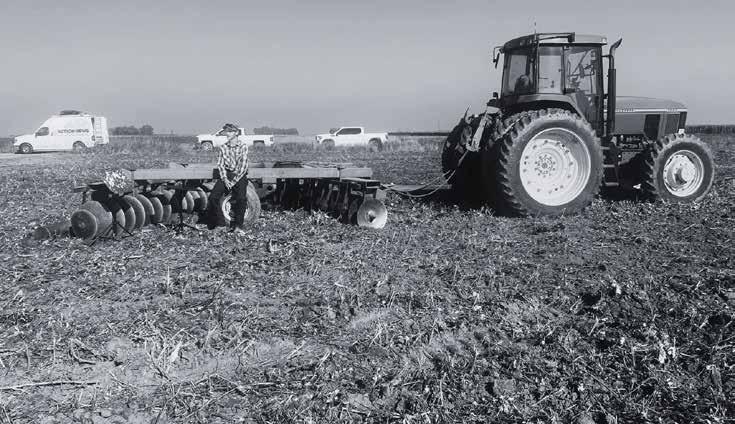


Beginning Farmers & Ranchers Mentorship Program
Enroll in a New Program Aimed at Preserving California’s Agricultural Heritage.
Beginning farmers and ranchers in California face many challenges in sustaining their agricultural operations. This program provides no-cost mentoring services from experienced farmers and ranchers to facilitate knowledge transfer.
Who can become a mentor?
Farmers (including specialty crop growers) and ranchers with more than 10 years of experience operating a production agriculture business in California can become mentors.
Benefits of becoming a mentor:
• Receive incentive pay ($50/hr) for up to six hours of time invested in mentoring a beginning farmer and/or rancher.
Who can become a mentee?
• Share knowledge, skills, and experience to help guide the long-term success of a beginning farmer and/or rancher in California.
Farmers (including specialty crop growers) and ranchers with one to 10 years of experience operating a production agriculture business in California can become mentees.
Benefits of becoming a mentee:
• Learn from experienced farmers and ranchers through six hours of mentoring.
• Attend biannual workshops alongside subject matter experts and peers.
• Enjoy annual subscriptions to the Ag Alert® weekly newspaper and Farm Bureau Extension classes.

• Work towards self-declared goals such as adopting new management practices, scaling production and distribution, learning established and emerging marketplaces, improving business accounting and finance fundamentals, and more.
To enroll as a mentor or mentee, complete an online application at cfbf.com/EOR. Information from the online application will be used to match mentors and mentees.
Funding for this Project was made possible by a grant/cooperative agreement from the U.S. Department of Agriculture (USDA) Agricultural Marketing Service and National Institute of Food and Agriculture. Its contents are solely the responsibility of the authors and do not necessarily represent the official views of the USDA.

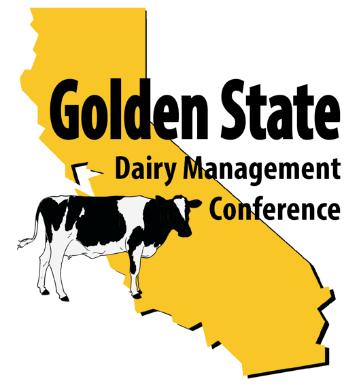


California research to address dairy needs
We're excited to welcome Corey Geiger, Lead Dairy Economist of CoBank's Knowledge Exchange as our keynote speaker to discuss dairy's bright future.
Scientific sessions will provide research updates from University of California Advisors, Specialists and Faculty.





New Cal/OSHA chair signals a less combative approach to agtech issues
By: Brad Hooker, Agripulse
Governor Gavin Newsom has reshuffled the chairs in a board that has often served as an impediment to scaling up agtech adoption in California. And the change may be paying off for the industry.
Joseph Alioto, a trial attorney, took over in June as the new chair of the standards board governing the Division of Occupational Safety and Health, or Cal/ OSHA. The appointment was an attempt to ease the tension between the administration and the board. Last March the board was set to approve new rules for indoor heat protections, despite industry outcry over the potential implementation costs. Yet the looming financial hit to corrections facilities drove the Department of Finance to pull its support for the draft regulation the night before the hearing. Dave Thomas, board chair at the time, voiced his frustration over the decision at the hearing, calling it “just bullshit” and shouted at protestors to “stop this shit right now.”
The chaotic meeting came on the heels of business groups pleading for “less vitriol” towards employers by agency staff. Helen Cleary, director of the Phylmar Regulatory Roundtable, said she had “never in my career felt such a lack of trust or disregard” for the concerns of the business community.
The governor’s office did not respond to requests for comment over Thomas’ outbursts but quietly demoted him three months later and
removed another board chair, who similarly criticized the administration’s decision, while installing Alioto.
One of the new chair’s first acts was to back a petition for new requirements to prevent sliding gates from falling and injuring workers, while taking a slightly different approach to crafting the regulation. The board has for years shot down attempts to revise a longstanding ban on autonomous tractors and last year dismissed calls by the agriculture industry to establish a stakeholder advisory committee to examine the issue in more depth. Alioto’s board immediately established a committee to examine the sliding gates petition and agricultural representatives eagerly volunteered to serve on it.
Under Alioto, the standards board has also reopened the conversation over regulating emerging technologies in agriculture and, rather than criticizing agencies like the finance department, has reached out to its fellow regulators for inspiration. At its most recent hearing, the board invited the California Department of Pesticide Regulation to
explain an innovative new program for exploring emerging technologies in partnership with manufacturers and academics.
“I really wanted this group to be a collaborative effort between different regulators in and outside of California who are working on these technologies,” said Emily Bryson, a senior environmental scientist at DPR. “Regulators are all running to keep up with the pace of these technologies and how quickly they're evolving.”
Bryson has built on her experience from serving on a two-year U.S. EPA
work group on emerging technologies. She assembled a cohort composed of University of California researchers and extension specialists in the fields of agricultural engineering, business innovation and weed science. She brought in several officials at DPR, Cal/OSHA and the California Department of Food and Agriculture, while attracting interest from the Department of Water Resources.
Through guest presentations and roundtable discussions, the group has begun to gather information
See 'Ag Tech' Page 20

Ag Tech
continued from page 19
about a range of technologies, from unmanned aerial vehicles to retrofitted tractors. The equipment must relate to pesticide application and, while laser weeders “are very cool,” they do not fall within the department’s jurisdiction, explained Bryson. They also review current and proposed state and federal policies and “a lot of international regulations,” particularly with the popularity of pesticide drones in Asia.
“Looking at what they've done really has laid some of the groundwork for us,” said Bryson.
She is sharing the findings with pesticide regulators in other states, who are often an overwhelmed staff of two in “tiny departments.”
While still early in the process, the discussions so far have revolved around technologies in development, worker and bystander safety, potential regulations to address specific tech issues, and how well the current regulatory framework fits the products coming to market.
“We’re trying to keep our finger on the pulse of what's happening and ensure that if we are drafting regulations, we try not to do anything too prescriptive, so we don't inhibit future progress and eventually make this process safer,” she said.
Connectivity came up as one surprising issue in the discussions. Rural areas often lack adequate broadband access for wireless connections and satellite links can have a lag time in sending signals to remote machinery, raising concerns for spray drift during applications. Bryson discovered the
technologies tend to have multiple layers of connections and several fail safes in place, immediately shutting off the equipment at signs of danger.
The group has hosted thornier discussions around liability. DPR does not regulate the equipment but the person on it. With artificial intelligence and machine learning, deciding when and where to apply, however, “it gets a lot trickier.”
“We're a department of scientists. We're not engineers,” said Bryson. “So we really had to learn on the fly with a lot of this, and that's why it was really important to gather this information.”
The work has also informed the industry. Established manufacturers like John Deere have made significant inroads into the agtech space, but so have small Silicon Valley startups new to agriculture.
“[The startups] don't necessarily have the onfarm experience and a lot of them aren't even aware that DPR exists,” she said. “They don't know that the second their machine starts spraying pesticides, they're subject to an entirely new set of regulations.”
The state has issued 386 licenses for applying pesticides by unmanned vehicles. That number has been rising since Newsom signed a bill last year, sponsored by the California Farm Bureau, to modernize the training process for drone applicators.
Every time someone visits a healthcare facility
anywhere in California for a potential pesticide exposure or they call poison control, DPR receives a report. From 2017 to 2021, the state logged 582 cases of pesticide exposure related to agriculture. Yet no cases have been reported for any of the emerging technologies on Bryson’s radar.
While the level of safety increases, environmental impacts drop. Breakthroughs in precision agriculture have led to more targeted applications, moving away from broad sprays along every row. Some agtech equipment can cut pesticide use in half by simply stopping applications between trees within an orchard and sensing tree height to prevent overspraying, explained Bryson. Such technologies dovetail with the administration’s goal of reducing use through its sustainable pest management strategy.
To industry trade groups, Bryson’s presentation was nothing new. Farmers have long eyed agtech solutions to lower labor costs and reduce expenses on pesticides, fertilizers and water — and several agricultural representatives had previously briefed the board on the safety and environmental benefits as well.
“We've been talking about autonomous equipment for quite a while,” said Michael Miiller, director of government relations at the California Association of Winegrape Growers. “The best way to really protect people from [pesticide] products is to scale back the use of the product.”
He noted that some machines can scan vineyards for diseases like red blotch and spray only the spots with problems, drastically reducing applications while eliminating the potential exposure to people. Through such practices, growers can more readily comply with DPR’s requirements, while supporting CDFA’s pursuit of lowering inputs through regenerative agricultural practices and adhering to pending zero-emission mandates from the California Air Resources Board. That agency has offered incentives for farmers to upgrade to electric tractors, equipment that typically comes paired with autonomous systems — potentially aligning it with Cal/OSHA’s workplace safety rules.
The standards board under Dave Thomas, however, routinely sided with
See 'Ag Tech' Page 21

Ag Tech continued from page 20
labor groups in opposing automated farm machinery.
“This is an emerging technology and we need to go very slowly,” said Anne Katten, a policy advocate for the California Rural Legal Assistance Foundation.
Katten argued workers still face the risk of exposure when loading autonomous sprayers or when operating partially automated equipment and said retrofitted tractors pose issues with quality control and liability. She also worried about environmental impacts. While the precision tools use less pesticide individually, more machines in the field could put more pesticide in the air, she reasoned.
Alioto was the only board member to take part in the discussion, asking Bryson probing questions about where the two agencies may overlap in their regulations. In some cases, traditional equipment, for instance, has sprayed and struck a bystander at the same time.
While the conversation was light, it was more positive than discussions last year, when board members criticized manufacturers for a lack of worker safety
data specific to California and echoed labor concerns that autonomous technologies are still too dangerous.
Alioto and the board will learn more about the emerging agtech trends later in October, when they take part in a tour of the FIRA USA robotics conference in Woodland. At last year’s
conference, the outgoing executive officer for the standards board, Christina Shupe, brought the debate to farmers when she defended the agency’s cautious approach to technology.
“A lot of times government gets a bad rap for being folks in an ivory tower who are not educated

about what's going on in the real world, boots on the ground,” said Shupe. “When we pass regulations in California, these are laws. We in particular at the standards board know how critical it is to make sure they work and are feasible, that they're reasonable and that they're enforceable.”
Farm
City’s
Forty-Eighth Annual Banquet Dinner Fundraiser
Honoring outstanding citizens of Merced County in their Ag related fields to benefit local students to further their education in agriculture
SAVE THE DATE
Saturday, November 16, 2024 AT Merced County Fairgrounds
Merced, CA 6:30 PM -10:00 PM
Please contact any one of the following people for tickets:
Dori Silva, Hannah Cole, Stacy Jasso, Gina Rosas, Vikki Dompe, Robert Sylvester, Matt Jasso, Nikki Maddux, Jack Hurley
If you know of an individual/family/business you believe should be nominated, please complete the form below and submit it to Agribusiness Committee of Merced County PO Box 2731 Merced, CA 95344 by October 1, 2024 For questions call 209-675-6348, 209-675-6480 or 209-675-3458
Name of Nominee ___________________________________________________________________________________________
Address of Nominee___________________________________________________________________________________________
Phone Number of Nominee __________________________________________________________________________________
Circle the Category for Nominee: Agri-Business Ag-Education Livestock/Dairy Trees/Vines Field Crops Nominated By_

Price Controls
Just when we thought we had been regulated to death, Kamala Harris is planning to up the ante! With grocery prices through the roof, and inflation at astronomic levels, Americans are in desperate need of financial relief. Farmers and ranchers have been struggling to keep their businesses afloat and are looking for a light at the end of the tunnel. That tunnel looks very dark and Kamala’s proposed plan feels like a train barreling out of control.
Vice President Kamala Harris has revealed her new plan to regulate food prices in an effort to make groceries more affordable for American families. While the intention appears to be honorable, Harris’s proposal is packed with unintended consequences that threaten to exacerbate rather than improve the problems it’s trying to address.
Harris’s plan is a strategy to enforce price controls on groceries, supposedly to restrain inflation and ease the financial drain on consumers. On paper, this may seem like a practical approach. Nevertheless, price controls have historically proven to be an unreliable solution with unintended consequences. By setting artificial limits on prices, Harris’s plan risks creating a multitude of new problems, from shortages to reduced quality of goods,
increasing black-market activity and long-term economic instability.
Harris’s plan also increases concerns about its effect on small grocery stores, farmers and ranchers. If indeed they are forced to sell products below market value, these businesses will struggle even harder to survive. Inflation is obviously a compound problem, driven by a variety of causes, including supply chain disruptions, labor shortages, printing more money and global economic conditions. A simplistic price control measure does little to address these fundamental issues and may, in fact, divert attention from more effective, long-term solutions.
Harris’s price control plan looks a lot like Socialism, and there is no room for Socialism in our free market
system. Allowing businesses to take care of their business with less government control would be a great way to reduce inflation and grow our economy. In these unstable economic times, I encourage farmers, ranchers
and conservators to invite friends, neighbors and family members to join the collective voice of the Farm Bureau. Together, we can make our organization stronger than ever, one member at a time.




